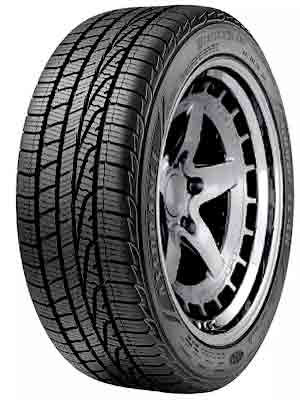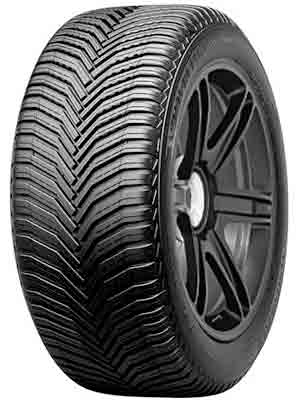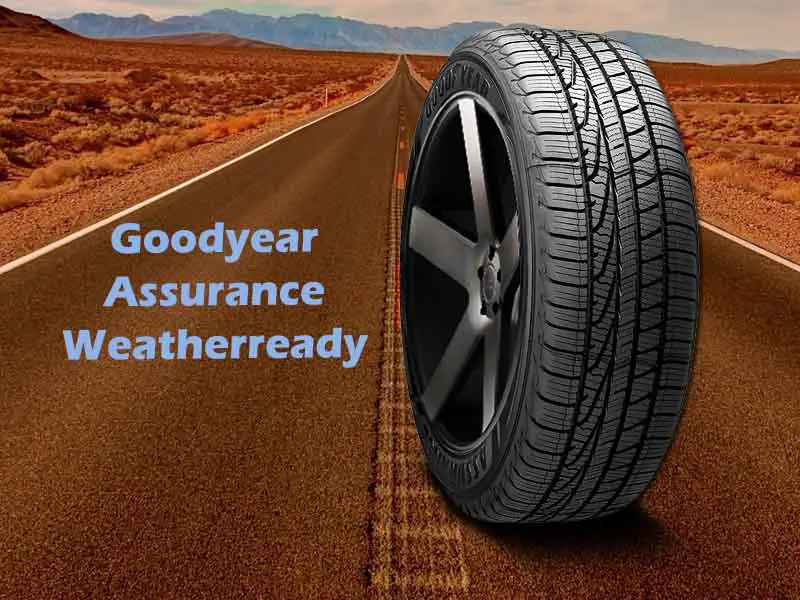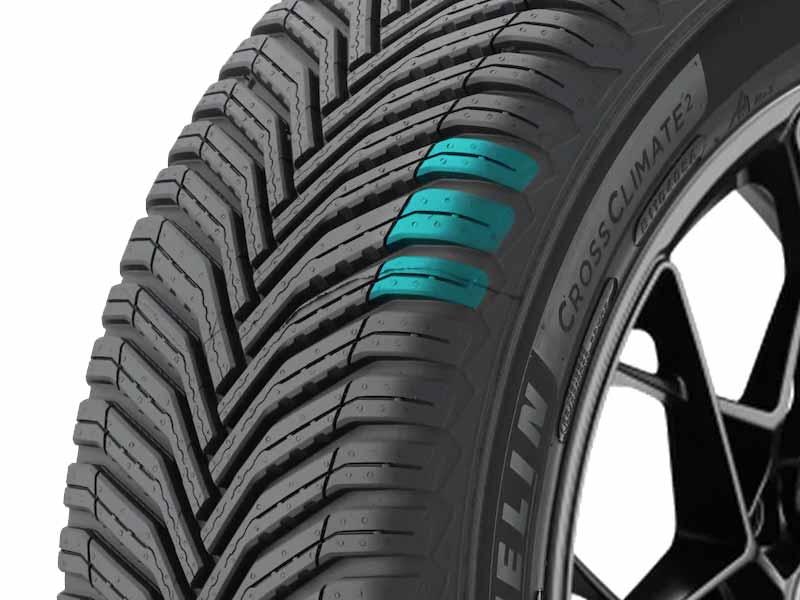Both the Goodyear Assurance Weatherready and Michelin Crossclimate 2 are all premium all season tires where both can be used in summer as well as extreme snowy conditions, that’s why both tires are branded with M+S and 3 peak mountain snowflake rating symbols (3PMSFR).
Both tires are very light in weight as they both carry 2 ply polyester casings, with 2 wide steel belts on top, reinforced with a single layer of polyamide, so with less rigidity these tires are capable of giving you a very comfortable ride along with a responsive steering feedback.

After hours of testing both tires, our teams landed on a few key points, which I think worth discussing before moving forward, the Michelin Crossclimate 2 is no doubt a better tire for snowy performance, the tire features a lot of things in common with dedicated winter tires. At the same time it’s also better on dry roads. But still the tire lacks on wet, and that’s where the Goodyear Assurance Weatherready comes in with it’s remarkable handling and braking distances on wet roads.
Table of Contents
Overview of both tires
Goodyear WeatherReady

Michelin Crossclimate 2

Goodyear Assurance WeatherReady is provided with an open asymmetric tread design where the 3 middle ribs make 4 aqua channels, which offer decent hydroplaning resistance.

The Goodyear Weatherready’s vertical central ribs are abundant with highly efficient 3D active sipes. These sipes are zigzag and cover the central tread but on the shoulder ribs, they are rectilinear.
The tread overall provides comparatively greater tread depth and wider channels where its shoulder ribs are slightly elevated from its central tread.
One of its central tread layers offers a diagonal groove penetration giving extraordinary biting ability.
Moreover, it is certified with Weather Resistant and Tredlock Technologies. And, its Evolving Traction Grooves are proved highly profitable in navigating it through snowy terrains.
In comparison, its shoulder blocks have wider lateral grooves that are also curved (because of this the curved float speed is improved).
Note: The float speed simply tells you how much speed a tire can run over water without floating.
But a lot of grooves and sipes (meaning overall tread features), a lot rubber area is eaten away (that would have been in contact with the pavement), so the tire lacks in terms of grip (compared to Michelin Crossclimate 2).
Speaking of which this tire offers a directional design as you can see it’s tread below.
The Michelin Crossclimate 2 is provided with closely packed diagonally placed tread layers (but only in the middle).

It’s lugs are V-shaped and are divided into two poorly differentiated rows, where the shoulder ribs are not much prominent & are slightly flattened compared to its central tread.
Its closed tread design provides comparatively narrower longitudinal grooves but its lateral grooves are slightly broader which don’t meet the road as much, comparatively.
The distribution of its sipes is also not much efficient as compared to its rival. (The sipes on its lateral tread are rectilinear while on its central tread, they are zigzagged).
Moreover, its central blocks are cornered with V-Ramp Chamfers which promote the biting potential (which is very effective).
Each tread layer contains one or two zigzag sipes. Its grooves are shallower and leaner as compared to its opponent and its shoulder ribs are not prominently differentiated. Moreover, higher tread volume grants it a higher weight-bearing capacity.
Also Read:
https://comparethetire.com/how-to-tell-if-tires-are-all-season/
https://comparethetire.com/tread-design/
Tire Performance Comparison
To judge performance of an all season tire, there are few crucial things to consider, those include hydroplaning and rolling resistance, tread noise, driving comfort and durability.
Both tires are almost equally durable and have similar inner construction of 2 ply polyester – 2 steel belts – 1 ply polyamide, but still the Crossclimate 2 provides better absorption to bumps but lacks in noise.
The Goodyear Assurance Weatherready on the other hand, provides better wet grip and hydroplaning.
Let’s discuss all of these factors in detail.
Road Grip Comparison
| Grip | Weatherready | Crossclimate 2 |
| Dry Grip | Average | Better |
| Wet Grip | Better | Average |
| Ice Grip | Above average | Average |
| Snow Grip | Average | Better |
The Goodyear Weatherready with a lot of grooves and tread features don’t allow as much contact with the road.
But still the performance is average consider other all season premium tires.
Its softer compound sticks well on roads, where the notches provide biters for the grip while both braking and handling.
But its softer compound is much better on wet roads as they provide the needed flexibility to the sipes which suck in the water particles and spray out as the tire rolls over.
That’s how sipes basically work.
Another part contributing to wet traction is hydroplaning, and this tire with wider grooves allows more water to evacuate in comparison.
Moreover, the biters also enhance this wet grip further.
On the other side, the Michelin Crossclimate 2 although offers a wider lateral grooves on the shoulder blocks, it’s lugs with directional design get very compact in the middle, and with the tire’s rounded contact patch, much of the tire road to rubber contact is made.
So this tire with it, provides one of the best grip values that you can get.
Similiarly with rounded contact patch, the high speed stability becomes very sporty. But the tire lacks in wet, where siping is very improtant, and in order to increase rubber to road contact, that is compromised.
But again with rounded contact patch as most rubber meets in the middle Crossclimate 2 offer interlocking sipes there so overall grip is not compromised by a lot.
But its still better in Goodyear Assurance Weatherready where there are numerous sipes. On wet roads, its deeper channels along with highly efficient sipes allow smoother handling as they are highly productive in wiping away water.
Michelin Crossclimate 2 has stronger dry traction and is easier to handle on dry paths. Its greater tread contact promotes its grip and simultaneously the handling on dry paths. However, due to its comparatively less efficient water-repelling structure and limited sipes, it is harder to handle on wet pathways.
Winter Performance
All season tires basically provide a compromise in both summers and winters, so they can not provide good enough traction in hotter seasons like summer tires, and similarly can’t perform as great as dedicated winter tires with colder temperatures.
But when it comes to these two tires, the compromise is very little. As both of them are branded with 3 Peak Mountain Snowflake rating.
The Michelin Crossclimate 2 provides better handling and grip in on road snow (average snowy roads) and slightly deeper snow.
Goodyear Assurance Weatherready, on the other side is better with icy roads as it offers more sipes which bite in to the surface and provide ample traction.
But with deeper snow, the tire cant outperform Crossclimate 2 which has swooping lugs with it’s directional design, and notches which trap in the snow and make a better snow to snow contact.
Hydroplaning Resistance
3D sipes having a zigzag shape are abundantly distributed over the tread of Goodyear Weatherready which are highly impressive in their performance. They actively wipe away water resulting in smooth navigation through wet terrain.
Moreover, its broader and deeper channels are highly effective in evacuating maximum water to assist tire’s movement through wet paths. These features collectively promote its hydroplaning resistance.
Crossclimate 2 is provided with limited 3D sipes which reduce its traction on wet terrain. Each tread block is provided with only one or two sipes so it can’t perform as excellently as its counterpart on wet surfaces.
Moreover, its shallower channels are not much wide and are unable to promote its traction in the water. So, this tire offers lower hydroplaning resistance compared to its competitor.
Rolling Resistance
Allowing a smaller part of its tread to come in contact with the road, Weatherready offers lower rolling resistance. Its lower rolling resistance not only promotes its fuel efficiency but also reduces tread wear, resulting in longer tread life.
Greater tread contact of Crossclimate 2 results in a higher rolling resistance which results in more fuel consumption and reduces its mileage.
Moreover, higher rolling resistance offers greater friction to the movement of the tire and results in more tread wear.
Noise and Comfort
Weatherready allows minimal contact with the road as it has deeper and broader tread grooves which trap more air particles into them. These particles strike continuously with the walls of the grooves producing sharp noise and reducing the comfort level of the tire.
Whereas, Crossclimate 2 has narrower and more profound channels allowing lesser air particles to get entangled in them.
These air particles, however, strike the groove walls to produce noise but this noise is comparatively lower than that of its opponent. So, it gives a more comfortable and smoother ride.
Tread Compound and Structure
| Composition | Weatherready | Crossclimate 2 |
| Tread Compound | Soybean | Thermal adaptive all-season |
| Tread Pattern | Open | Closed |
| Tread Layers | Vertical (three rows) | Diagonal (two rows) |
| Sipes | 3D zigzag / rectilinear | 3D zigzag / rectilinear |
| Grooves | Deeper / Wider | Shallower / Leaner |
| Shoulders | Elevated / having wider channels | Flattened / having narrower channels |
Weatherready’s tread compound features soybean oil which maintains the flexibility of the tread even in freezing temperatures. This soy-based tread compound also enhances its traction on snowy and icy terrains.
Moreover, its Weather Resistant Technology assists in maintaining its rigidity throughout the year. Its structure includes vertically placed three central ribs abundant with highly effective 3D sipes. Its tread depth is more compared to its rival and its central and shoulder grooves are broader.
Crossclimate 2 is provided with a thermal adaptive all-season compound which allows it to cope with extreme weather conditions. This thermal adaptive compound gives better temperature resistance and allows it to perform excellently in the winter season.
However, this tread compound is comparatively softer, giving lower treadwear resistance. The tread layers of this tire are divided into two rows making a V-shape at their point of contact. The grooves are comparatively leaner and sipes are less abundant. Its central tread is slightly elevated in comparison with its shoulder ribs.
Treadwear and Durability
Both tires like discussed above have a carass of 2 polyester layers. These layers are then covered with 2 more layers of steel made cords which make belts.
All of this is then layered with another polymer, named Polyamide (which adds to the durability overall provides even tread wear capabilities).
| Durability | Weatherready | Crossclimate 2 |
| UTQG | 700 A A | 640 B A |
| Treadwear Warranty | 60,000 | 60,000 miles |
| Uniformity Warranty | 1 year first 2/32” | 1 year first 2/32” |
Goodyear Weatherready offers comparatively lower rolling resistance which results in slower tread consumption. It has deeper grooves and the tread takes more time to get leveled with them. So, this tire offers lower tread wear and higher durability. Its tread wear warranty is same as that of its peer but has a better UTQG rating.
On the other hand, the Michelin Crossclimate 2 has a higher rolling resistance which results in more treadwear. It has shallower grooves which causes the tread to get consumed in lesser time, reducing its durability.
Moreover, its uniformity warranty is same as that of its rival but has a lesser UTQG rating.
Take Home Points:
The Goodyear Assurance Weatherready overall offers a stronger grip and better handling on wet, snowy and ice-covered paths as the tire has more biters to it which hold on to the surface much more nicely.
Moreover, with wider channels the hydroplaning resistance of this tire is also very surprising on both straight and curved paths.
And lastly, with lower rolling resistance, this tire also lasts more and consumes less amount of fuel.
The Michelin Crossclimate 2 is although very expensive, it justifies it’s price tag with amazing snow performance where it’s dry grip is also going to impress.
The tire makes a little noise but overall comfort is better with it, overall.
The following two tires were compared, you can check out other technical specs about them below:
| Specifications | Weatherready | Crossclimate 2 |
| 3PMSFR | Yes | Yes |
| Tested Size | 235/60R18 | 235/60R18 |
| Tread Depth | 11/32” | 10/32” |
| Section Width | 9.5” | 9.4” |
| Max. Inflammation Pressure | 51 psi | 50 psi |
| Max. Load | 1929 lbs | 2149 lbs |
| Tire Weight | 28.0 lbs | 29.9 lbs |


